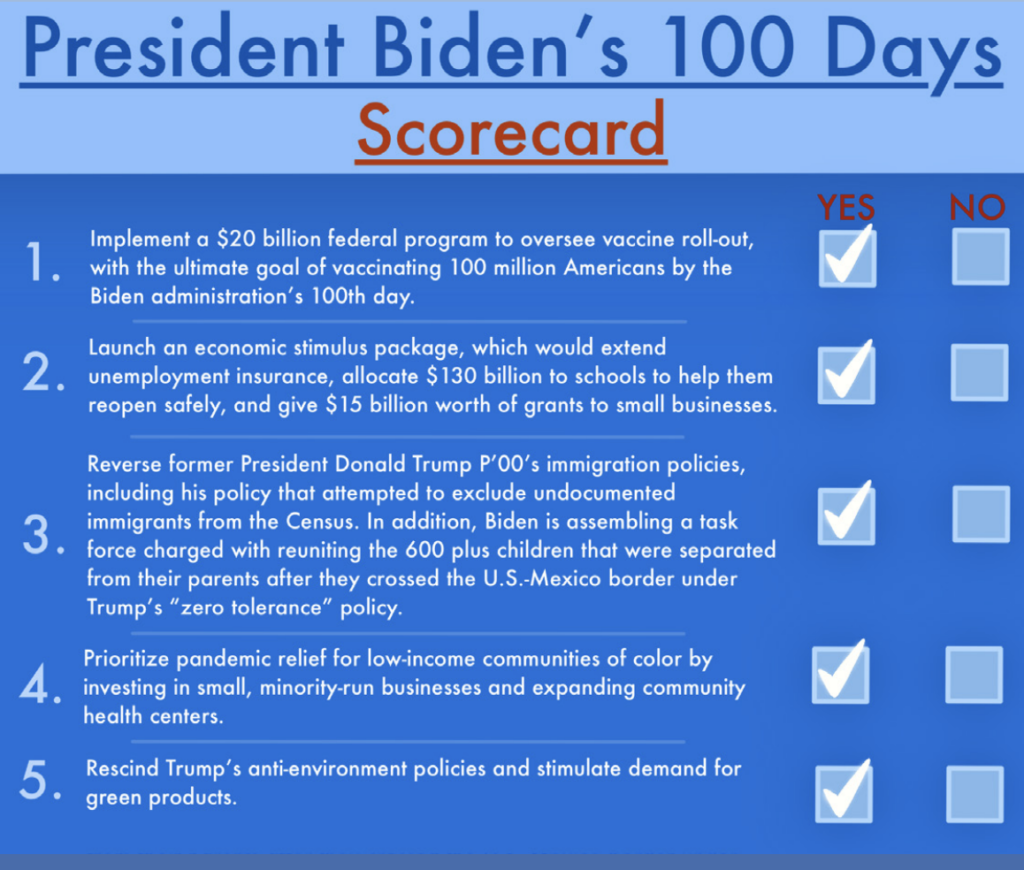
Graphic by Yujin Kim/The Choate News
A president’s first 100 days sets the expectation for their remaining time in office. President Joe Biden’s first 100 days, which ended on April 28, were spent addressing the two biggest crises in the US: the coronavirus pandemic and the economy. His intention has been to boost government aid and regain trust while keeping his policies equitable. While Biden fulfilled all the areas mentioned on the scorecard, his mediocre response to the crisis at the US-Mexico border is concerning. But, there are still three years remaining for Biden to make progress on pressing issues and changes that will affect America for generations to come.
The Biden Administration made remarkable progress in speeding up the vaccine rollout started under President Trump P ’00 and more than doubled the goal of getting 100 million Americans fully vaccinated by the 100th day in office. The Defense Production Act was put to good use in speeding up Pfizer-BioNTech and Moderna vaccine production and increasing the availability of at-home Covid tests and critical medical equipment such as masks, gloves, and shields.
In March, Congress passed a $1.9 trillion relief package — the American Rescue Plan — that allocated $160 billion to the mass vaccination program with $10 billion invested in building vaccine confidence and expanding its access to high-risk communities. This is crucial to helping communities of color, especially Black and Hispanic communities, who have suffered the most during the coronavirus. The next goal is to vaccinate 300 million Americans by early fall, something the Biden Administration has indeed proved their ability to do, leaving individuals, states, and citizens to finish the job.
The American Rescue Plan had an extensive economic objective that allowed millions of working Americans to receive $1,400 stimulus checks. The eligibility of the unemployment insurance was extended, and states, local governments, and schools would receive financial assistance. $170 billion went to K-12 schools and institution of higher education, with $130 billion allocated to help schools reopen. Biden plans to further combat unemployment and the climate crisis through the building infrastructure with the help of the American Jobs Plan. The administration counts on increased taxes on wealthy Americans and investment into the IRS to pay for these projects. Although Biden’s plan looks good on paper and seems to be boosting economic recovery, time will be the only indicator of success.
On his first day in office, Biden took swift action to address immigration, but his progress has slowed since. On January 20, Biden signed multiple executive orders reversing Trump’s immigration policies, one of which required noncitizens, including undocumented immigrants, to be counted in the US Census. On February 20, he created a task force charged with reuniting children with their parents at the border. Since then, as many predicted, a large number of migrants crowded at the US-Mexican border. This surge has caused a crisis, with the solution being a risky overhaul of immigration policy and addressing the core issues causing mass migration. Biden must pay the same attention to this issue as he has to coronavirus and the economy due to the more than 100,000 migrants who need urgent help and long-term solutions.
Biden has done his part to help small businesses. The American Rescue Plan had devoted $15 billion to help small businesses, especially minority owned ones in low-income areas. The Paycheck Protection Program was improved to prioritize the smallest, rural, and minority owned businesses and its deadline was pushed to May 31. The Biden Administration has also increased vaccine distribution to community health centers. This is crucial for those living in poverty, ethnic and racial minorities, or the under and uninsured, who community health centers serve. Biden’s action towards small businesses and community health centers is a starting point towards his commitment to serve all Americans, not just the middle or upper class.
Biden has not fallen short on his commitment of prioritizing the climate, either. He has rejoined the Paris Climate Accord, canceled the Keystone XL pipeline, and filled his environment team with experts and advocates willing to take bold action. From Day One, he began reversing Trump’s anti-environment policies through executive orders aimed at reducing drilling on federal lands, and will soon replace his rule on methane pollution with a stronger one. He has also announced his goal of cutting greenhouse gases below 2005 levels by 2030, an ambitious plan that will be achieved by the American Jobs Plan, which will provide funding to climate research and solutions. The Biden Administration will need to continue this speed throughout the term to combat this issue.




